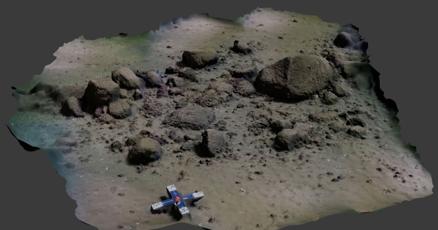A MYSTERY megastructure dubbed the Underwater Stonehenge has been found at the bottom of the sea.
The ancient submerged wall, estimated to be around 10,000-years-old, might even be “Europe’s oldest structure” as scientists try to figure out exactly what it is and where it came from.
Made out of 1,670 stones and stretching for more than half a mile, the wall was located about 69 feet beneath the Baltic Sea and around six miles off the coast of Rerik, Germany.
The discovery had been made by researchers and students from Kiel University in Germany as they conducted a marine geophysical survey along the seafloor of the Bay of Mecklenburg.
The Mecklenburg-Vorpommern State Office for Culture and Monument Preservation were soon alerted, before diving teams and an autonomous underwater vehicle were sent to investigate.
With the rocks being too perfectly aligned to have been made by natural events, the team decided the wall was likely built by Stone Age communities to hunt reindeer more than 10,000 years ago.
Read more in Science
A study describing the structure was published on Monday (February 12) in the journal Proceedings of the National Academy of Sciences.
It explains how the wall’s layout and close proximity to water means it was likely to have been used by hunters to guide reindeer into a “bottleneck” in order to kill them more easily.
“At this time, the entire population across northern Europe was likely below 5,000 people,” said study coauthor Dr. Marcel Bradtmöller, research assistant in prehistory and early history at the University of Rostock in Germany.
“One of their main food sources were herds of reindeer, which migrated seasonally through the sparsely vegetated post-glacial landscape.
Most read in Science
“The wall was probably used to guide the reindeer into a bottleneck between the adjacent lakeshore and the wall, or even into the lake, where the Stone Age hunters could kill them more easily with their weapons.”
The hunter-gatherers used spears, bows and arrows to catch their prey, Bradtmöller said, and are likely to have guided the reindeer into the lake because they were slow swimmers.
Lead study author Dr. Jacob Geersen, senior scientist at the Leibniz Institute for Baltic Sea Research in Germany, believes the hunter-gatherer community recognised the deer would follow the wall.
“It seems that the animals are attracted by such linear structures and that they would rather follow the structure instead of trying to cross it, even if it is only 0.5 meters (1.6 feet) high,” he said.
In order to analyse how the region has evolved to determine the approximate age of the wall, the research team collected sediment samples from the rocks.
They then created a 3D model of the wall and virtually reconstructed the landscape where it was originally built.
According to study authors, the wall was flooded and therefore submerged as a result of rising sea levels at the end of the last ice age.
But the wall’s discovery could now change the way researchers think about highly mobile groups like hunter-gatherers.
Bradtmöller explains how building a massive permanent structure like the wall implies that these regional groups may have been more location-focused and territorial than previously believed.
Other prehistoric hunting structures have been found elsewhere around the globe, including the United States and Greenland.
And in Saudi Arabia and Jordan, researchers have discovered traps known as “desert kites.”
But the latest discovery marks the first Stone Age hunting structure to be found in the Baltic Sea.
But researchers aren’t stopping there, with scientists continuing their investigation in the Baltic using sonar and sounding devices, as well as planning future dives to search for archaeological finds.
It’s hoped that other undiscovered treasures at the bottom of the Baltic could shed more light on ancient hunter-gatherer communities.
READ MORE SUN STORIES
“We have evidence for the existence of comparable stonewalls at other locations in the (Bay of Mecklenburg),”said study coauthor Dr. Jens Schneider von Deimling.
“These will be systematically investigated as well.”











